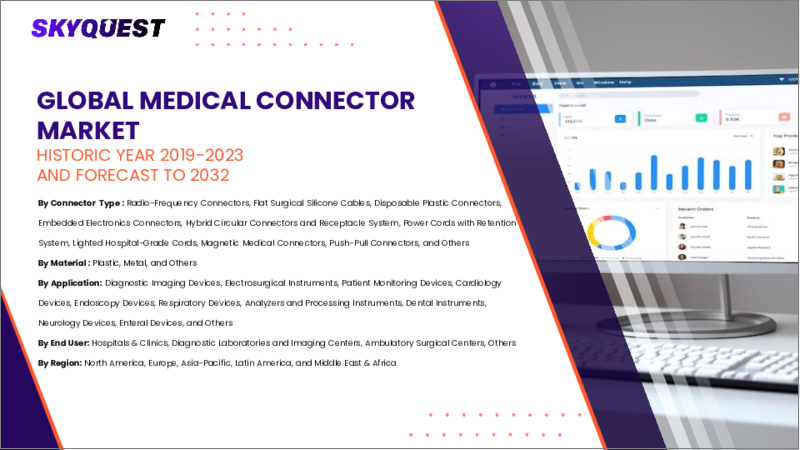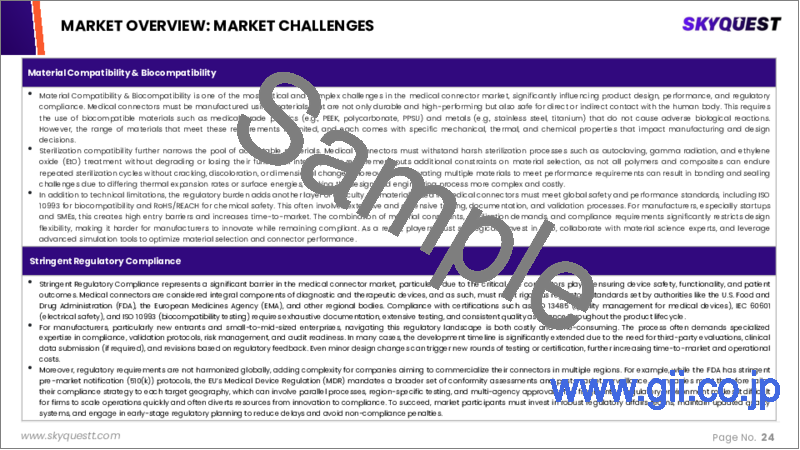|
|
市場調査レポート
商品コード
1633551
医療用コネクターの市場規模、シェア、成長分析、製品タイプ別、用途別、エンドユーザー別、地域別 - 産業予測、2025年~2032年Medical Connector Market Size, Share, Growth Analysis, By Product Type, By Application, By End-User, By Region - Industry Forecast 2025-2032 |
||||||
|
|||||||
| 医療用コネクターの市場規模、シェア、成長分析、製品タイプ別、用途別、エンドユーザー別、地域別 - 産業予測、2025年~2032年 |
|
出版日: 2025年01月12日
発行: SkyQuest
ページ情報: 英文 214 Pages
納期: 3~5営業日
|
全表示
- 概要
- 目次
医療用コネクターの世界市場規模は2023年に34億9,000万米ドルとなり、予測期間(2025-2032年)のCAGRは10.7%で、2024年の38億6,000万米ドルから2032年には87億1,000万米ドルに成長する見通しです。
世界の医療用コネクター市場は、ヘルスケアの中で急速に拡大している分野であり、技術の進歩と精密な医療機器への需要の高まりがその原動力となっています。医療画像、患者モニタリング、手術器具、診断ツールにおける技術革新は、特に遠隔医療の時代において、シームレスなデータ交換を保証する信頼性の高いコネクターの必要性を高めています。さらに、世界人口の高齢化と慢性疾患の蔓延がヘルスケアシステムに課題をもたらし、先端医療技術への投資に拍車をかけています。この動向により、患者の安全性と規制遵守を重視し、多様な医療用途に合わせた特殊なコネクターが必要とされています。業界の発展に伴い、効率的で安全な医療用コネクターへの需要は増加し、市場のメーカーや利害関係者に課題と機会の両方をもたらすことになります。
目次
イントロダクション
- 調査の目的
- 調査範囲
- 定義
調査手法
- 情報調達
- 二次データと一次データの方法
- 市場規模予測
- 市場の前提条件と制限
エグゼクティブサマリー
- 世界市場の見通し
- 供給と需要の動向分析
- セグメント別機会分析
市場力学と見通し
- 市場概要
- 市場規模
- 市場力学
- 促進要因と機会
- 抑制要因と課題
- ポーターの分析
主な市場の考察
- 重要成功要因
- 競合の程度
- 主な投資機会
- 市場エコシステム
- 市場の魅力指数(2024年)
- PESTEL分析
- マクロ経済指標
- バリューチェーン分析
- 価格分析
- ケーススタディ
- 規制情勢
- 特許分析
医療用コネクター市場規模:製品タイプ別& CAGR(2025-2032)
- 市場概要
- プッシュプルコネクター
- ハイブリッド円形コネクターとレセプタクルシステム
- 無線周波数コネクター
- 使い捨てプラスチックコネクター
- その他
医療用コネクター市場規模:用途別& CAGR(2025-2032)
- 市場概要
- 患者モニタリング装置
- 心電図モニター
- 血圧モニター
- 画像診断装置
- MRI
- CTスキャナ
- 電気外科用機器
- 電気外科用発電機
- 電気外科用器具
- 心臓病用機器
- ペースメーカー
- 除細動器
- 内視鏡装置
- 内視鏡
- 超音波内視鏡検査
- 呼吸器
- 人工呼吸器
- ネブライザー
- 分析装置および処理装置
- 血液分析装置
- 尿分析装置
- 歯科用器具
- 歯科用椅子
- 歯科用ハンドピース
- 神経学デバイス
- 神経刺激装置
- 脳波モニター
- 経腸デバイス
- 栄養チューブ
- 経腸ポンプ
- その他の用途
医療用コネクター市場規模:エンドユーザー別& CAGR(2025-2032)
- 市場概要
- 病院
- クリニック
- 外来手術センター
- 診断検査室
医療用コネクター市場規模:地域別& CAGR(2025-2032)
- 北米
- 米国
- カナダ
- 欧州
- ドイツ
- スペイン
- フランス
- 英国
- イタリア
- その他欧州地域
- アジア太平洋地域
- 中国
- インド
- 日本
- 韓国
- その他アジア太平洋地域
- ラテンアメリカ
- ブラジル
- その他ラテンアメリカ地域
- 中東・アフリカ
- GCC諸国
- 南アフリカ
- その他中東・アフリカ
競合情報
- 上位5社の比較
- 主要企業の市場ポジショニング(2024年)
- 主な市場企業が採用した戦略
- 市場の最近の動向
- 企業の市場シェア分析(2024年)
- 主要企業の企業プロファイル
- 会社概要
- 製品ポートフォリオ分析
- セグメント別シェア分析
- 収益の前年比比較(2022-2024)
主要企業プロファイル
- TE Connectivity Ltd.(Switzerland)
- Amphenol Corporation(USA)
- Smiths Group plc(UK)
- Rosenberger Hochfrequenztechnik GmbH & Co. KG(Germany)
- Kyocera AVX(USA)
- Fischer Connectors SA(Switzerland)
- Lemo SA(Switzerland)
- ITT Cannon(USA)
- Allied Connectors(USA)
- SK-Advanced Group(South Korea)
- Digi-Key Electronics(USA)
- Phoenix Contact(Germany)
- Harting Technology Group(Germany)
- Samtec, Inc.(USA)
- JAE Electronics(Japan)
- Hirose Electric Co., Ltd.(Japan)
- Molex Incorporated(USA)
結論と推奨事項
Global Medical Connector Market size was valued at USD 3.49 billion in 2023 and is poised to grow from USD 3.86 billion in 2024 to USD 8.71 billion by 2032, growing at a CAGR of 10.7% during the forecast period (2025-2032).
The global medical connector market is a rapidly expanding sector within healthcare, driven by technological advancements and a growing demand for precise medical devices. Innovations in medical imaging, patient monitoring, surgical instruments, and diagnostic tools have heightened the need for dependable connectors that ensure seamless data exchange, especially in the era of telemedicine. Additionally, the aging global population and rising chronic disease prevalence challenge healthcare systems, spurring investments in advanced medical technologies. This trend necessitates specialized connectors tailored for diverse medical applications, emphasizing patient safety and regulatory compliance. As the industry evolves, the demand for efficient and secure medical connectors is set to increase, presenting both challenges and opportunities for manufacturers and stakeholders in the market.
Top-down and bottom-up approaches were used to estimate and validate the size of the Global Medical Connector market and to estimate the size of various other dependent submarkets. The research methodology used to estimate the market size includes the following details: The key players in the market were identified through secondary research, and their market shares in the respective regions were determined through primary and secondary research. This entire procedure includes the study of the annual and financial reports of the top market players and extensive interviews for key insights from industry leaders such as CEOs, VPs, directors, and marketing executives. All percentage shares split, and breakdowns were determined using secondary sources and verified through Primary sources. All possible parameters that affect the markets covered in this research study have been accounted for, viewed in extensive detail, verified through primary research, and analyzed to get the final quantitative and qualitative data.
Global Medical Connector Market Segmental Analysis
Global Medical Connector Market is segmented by Product Type, Application, End-User and region. Based on Product Type, the market is segmented into Push-Pull Connectors, Hybrid Circular Connectors & Receptacle Systems, Radio-Frequency Connectors, Disposable Plastic Connectors and Others. Based on Application, the market is segmented into Patient Monitoring Devices, Diagnostic Imaging Devices, Electrosurgical Devices, Cardiology Devices, Endoscopy Devices, Respiratory Devices, Analyzers and Processing Instruments, Dental Instruments, Neurology Devices, Enteral Devices and Other Applications. Based on End-User, the market is segmented into Hospitals, Clinics, Ambulatory Surgical Centers and Diagnostic Laboratories. Based on region, the market is segmented into North America, Europe, Asia Pacific, Latin America and Middle East & Africa.
Driver of the Global Medical Connector Market
The Global Medical Connector market is being significantly driven by the continuous advancements in surgical procedures. As minimally invasive techniques gain popularity, there is an increasing demand for specialized medical connectors tailored for laparoscopic equipment, robotic surgery systems, and various surgical instruments. These innovative surgical approaches not only enhance patient recovery times and reduce complications, but they also require sophisticated connectors to ensure seamless integration and functionality of devices. Consequently, the growth of the medical connector market is closely tied to the evolution of surgical technology, highlighting the critical role these connectors play in modern healthcare solutions.
Restraints in the Global Medical Connector Market
The Global Medical Connector market faces significant challenges primarily attributed to high development costs. Creating and manufacturing medical connectors that adhere to the rigorous standards of reliability, safety, and performance set by the industry requires considerable investment in research and development. Furthermore, the financial implications are compounded by the expenses associated with necessary testing and certification processes. These factors can inhibit market growth as companies navigate the complexities of compliance while striving to deliver high-quality products, ultimately impacting their ability to innovate and expand within the competitive landscape of the medical device sector.
Market Trends of the Global Medical Connector Market
The Global Medical Connector market is witnessing a significant trend towards the adoption of disposable connectors, driven by their pivotal role in enhancing patient safety and operational efficiency. These connectors are increasingly favored in healthcare settings for their ability to mitigate cross-contamination risks, reduce maintenance costs, and streamline device design. As hospitals and surgical centers prioritize infection control and cost-effectiveness, the demand for single-use disposable medical connectors is surging, particularly in critical care and surgical applications. This shift not only reflects changing healthcare practices but also signifies a broader movement towards innovation and sustainability within the medical device industry.
Table of Contents
Introduction
- Objectives of the Study
- Scope of the Report
- Definitions
Research Methodology
- Information Procurement
- Secondary & Primary Data Methods
- Market Size Estimation
- Market Assumptions & Limitations
Executive Summary
- Global Market Outlook
- Supply & Demand Trend Analysis
- Segmental Opportunity Analysis
Market Dynamics & Outlook
- Market Overview
- Market Size
- Market Dynamics
- Drivers & Opportunities
- Restraints & Challenges
- Porters Analysis
- Competitive rivalry
- Threat of substitute
- Bargaining power of buyers
- Threat of new entrants
- Bargaining power of suppliers
Key Market Insights
- Key Success Factors
- Degree of Competition
- Top Investment Pockets
- Market Ecosystem
- Market Attractiveness Index, 2024
- PESTEL Analysis
- Macro-Economic Indicators
- Value Chain Analysis
- Pricing Analysis
- Case Studies
- Regulatory Landscape
- Patent Analysis
Global Medical Connector Market Size by Product Type & CAGR (2025-2032)
- Market Overview
- Push-Pull Connectors
- Hybrid Circular Connectors & Receptacle Systems
- Radio-Frequency Connectors
- Disposable Plastic Connectors
- Others
Global Medical Connector Market Size by Application & CAGR (2025-2032)
- Market Overview
- Patient Monitoring Devices
- ECG Monitors
- Blood Pressure Monitors
- Diagnostic Imaging Devices
- MRI
- CT Scanners
- Electrosurgical Devices
- Electrosurgical Generators
- Electrosurgical Instruments
- Cardiology Devices
- Pacemakers
- Defibrillators
- Endoscopy Devices
- Endoscopes
- Endoscopic Ultrasound
- Respiratory Devices
- Ventilators
- Nebulizers
- Analyzers and Processing Instruments
- Blood Analyzers
- Urine Analyzers
- Dental Instruments
- Dental Chairs
- Dental Handpieces
- Neurology Devices
- Neurostimulators
- EEG Monitors
- Enteral Devices
- Feeding Tubes
- Enteral Pumps
- Other Applications
Global Medical Connector Market Size by End-User & CAGR (2025-2032)
- Market Overview
- Hospitals
- Clinics
- Ambulatory Surgical Centers
- Diagnostic Laboratories
Global Medical Connector Market Size & CAGR (2025-2032)
- North America (Product Type, Application, End-User)
- US
- Canada
- Europe (Product Type, Application, End-User)
- Germany
- Spain
- France
- UK
- Italy
- Rest of Europe
- Asia Pacific (Product Type, Application, End-User)
- China
- India
- Japan
- South Korea
- Rest of Asia-Pacific
- Latin America (Product Type, Application, End-User)
- Brazil
- Rest of Latin America
- Middle East & Africa (Product Type, Application, End-User)
- GCC Countries
- South Africa
- Rest of Middle East & Africa
Competitive Intelligence
- Top 5 Player Comparison
- Market Positioning of Key Players, 2024
- Strategies Adopted by Key Market Players
- Recent Developments in the Market
- Company Market Share Analysis, 2024
- Company Profiles of All Key Players
- Company Details
- Product Portfolio Analysis
- Company's Segmental Share Analysis
- Revenue Y-O-Y Comparison (2022-2024)
Key Company Profiles
- TE Connectivity Ltd. (Switzerland)
- Company Overview
- Business Segment Overview
- Financial Updates
- Key Developments
- Amphenol Corporation (USA)
- Company Overview
- Business Segment Overview
- Financial Updates
- Key Developments
- Smiths Group plc (UK)
- Company Overview
- Business Segment Overview
- Financial Updates
- Key Developments
- Rosenberger Hochfrequenztechnik GmbH & Co. KG (Germany)
- Company Overview
- Business Segment Overview
- Financial Updates
- Key Developments
- Kyocera AVX (USA)
- Company Overview
- Business Segment Overview
- Financial Updates
- Key Developments
- Fischer Connectors SA (Switzerland)
- Company Overview
- Business Segment Overview
- Financial Updates
- Key Developments
- Lemo SA (Switzerland)
- Company Overview
- Business Segment Overview
- Financial Updates
- Key Developments
- ITT Cannon (USA)
- Company Overview
- Business Segment Overview
- Financial Updates
- Key Developments
- Allied Connectors (USA)
- Company Overview
- Business Segment Overview
- Financial Updates
- Key Developments
- SK-Advanced Group (South Korea)
- Company Overview
- Business Segment Overview
- Financial Updates
- Key Developments
- Digi-Key Electronics (USA)
- Company Overview
- Business Segment Overview
- Financial Updates
- Key Developments
- Phoenix Contact (Germany)
- Company Overview
- Business Segment Overview
- Financial Updates
- Key Developments
- Harting Technology Group (Germany)
- Company Overview
- Business Segment Overview
- Financial Updates
- Key Developments
- Samtec, Inc. (USA)
- Company Overview
- Business Segment Overview
- Financial Updates
- Key Developments
- JAE Electronics (Japan)
- Company Overview
- Business Segment Overview
- Financial Updates
- Key Developments
- Hirose Electric Co., Ltd. (Japan)
- Company Overview
- Business Segment Overview
- Financial Updates
- Key Developments
- Molex Incorporated (USA)
- Company Overview
- Business Segment Overview
- Financial Updates
- Key Developments






